 Vertical scanning interferometry is a well-established zero-contact surface characterization technique, but the analysis involved in interpreting the data is complex and computationally intensive. Wee Keat Chong at the A*STAR Singapore Institute of Manufacturing Technology and co-workers have now developed a computationally efficient model for this technique.
Vertical scanning interferometry is a well-established zero-contact surface characterization technique, but the analysis involved in interpreting the data is complex and computationally intensive. Wee Keat Chong at the A*STAR Singapore Institute of Manufacturing Technology and co-workers have now developed a computationally efficient model for this technique.
Jun 22nd, 2011
Read more
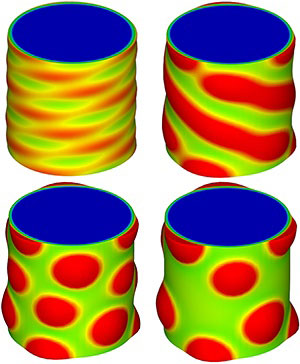 Three-dimensional dynamic simulations shows how the surface morphology of a nanowire changes when subjected to annealing.
Three-dimensional dynamic simulations shows how the surface morphology of a nanowire changes when subjected to annealing.
Jun 22nd, 2011
Read more
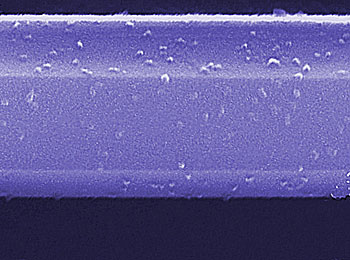 A team of researchers has made nano-sized sensors that detect volatile organic compounds - harmful pollutants released from paints, cleaners, pesticides and other products - that offer several advantages over today's commercial gas sensors, including low-power room-temperature operation and the ability to detect one or several compounds over a wide range of concentrations.
A team of researchers has made nano-sized sensors that detect volatile organic compounds - harmful pollutants released from paints, cleaners, pesticides and other products - that offer several advantages over today's commercial gas sensors, including low-power room-temperature operation and the ability to detect one or several compounds over a wide range of concentrations.
Jun 22nd, 2011
Read more
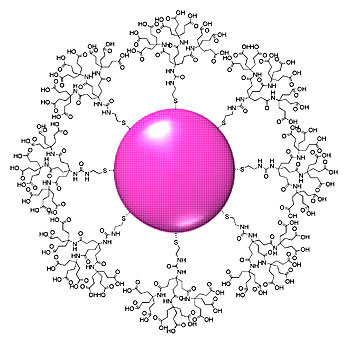 A new paper by researchers from the National Institute of Standards and Technology (NIST) and the National Cancer Institute's Nanotechnology Characterization Laboratory (NCL) proposes not only a sort of gold nanoparticle "testbed" to explore how the tiny particles behave in biological systems, but also a paradigm for how to characterize nanoparticle formulations to determine just what you're working with.
A new paper by researchers from the National Institute of Standards and Technology (NIST) and the National Cancer Institute's Nanotechnology Characterization Laboratory (NCL) proposes not only a sort of gold nanoparticle "testbed" to explore how the tiny particles behave in biological systems, but also a paradigm for how to characterize nanoparticle formulations to determine just what you're working with.
Jun 22nd, 2011
Read more
US Patent 7,964,143 discloses a nanoprobe array technique that allows for an array of individual, vertically-oriented nanotubes to be assembled at precise locations on electrical contacts using electrophoresis. The location of each nanotube in the array is controlled by a nanoscale electrostatic lens fabricated by a process commonly used in the manufacture of integrated circuits.
Jun 22nd, 2011
Read more
In a recent publication in Physical Review Letters, physicists at the University of Arizona propose a way to translate the elusive magnetic spin of electrons into easily measurable electric signals. The finding is a key step in the development of computing based on spintronics, which doesn't rely on electron charge to digitize information.
Jun 22nd, 2011
Read more
Researchers at Virginia Tech in Blacksburg, Va. recently found a way to improve electricity generating fuel cells, potentially making them more efficient, powerful and less expensive. Specifically, they discovered a way to speed up the flow and filtering of water or ions, which are necessary for fuel cells to operate.
Jun 21st, 2011
Read more
Using barium oxide nanoparticles, researchers have developed a self-cleaning technique that could allow solid oxide fuel cells to be powered directly by coal gas at operating temperatures as low as 750 degrees Celsius. The technique could provide a cleaner and more efficient alternative to conventional power plants for generating electricity from the nation's vast coal reserves.
Jun 21st, 2011
Read more
Every day, concrete structures crack and erode prematurely due to Alkali Silica Reactivity (ASR), a chemical reaction that causes fissures in the material as it sets. Jon Belkowitz, a doctoral student at Stevens Institute of Technology, plans to put an end to this problem through his study of chemical reactions within concrete at the nanoscale.
Jun 21st, 2011
Read more
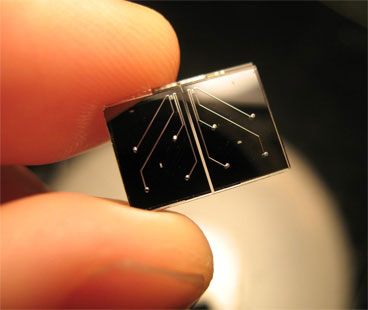 Combining an ancient principle with new technology, MIT researchers have devised a way to answer that question.
Combining an ancient principle with new technology, MIT researchers have devised a way to answer that question.
Jun 21st, 2011
Read more
Collaboration will drive the development of critical processes for advanced defect detection to support EUVL introduction.
Jun 21st, 2011
Read more
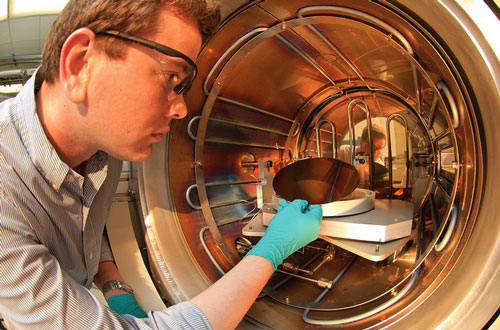 A simple tap from your finger may be enough to charge your portable device thanks to a discovery made at RMIT University and Australian National University.
A simple tap from your finger may be enough to charge your portable device thanks to a discovery made at RMIT University and Australian National University.
Jun 21st, 2011
Read more
Argonne's Center for Electrical Energy Storage is one of three Argonne-led Energy Frontier Research Centers (EFRCs) that were established in 2009 thanks to a special block grant from the U.S. Department of Energy that sought to establish five-year interdisciplinary programs focused around discrete scientific challenges.
Jun 21st, 2011
Read more
 The term "nanotechnology" covers a multitude of different technologies, and so a differentiated view of it is needed. This is the opinion of ETH Zurich Professor Christofer Hierold, whose research is in nanotechnology. He says that, to avoid risks and hazards, these must be analysed for each specific example of materials, structures and their applications.
The term "nanotechnology" covers a multitude of different technologies, and so a differentiated view of it is needed. This is the opinion of ETH Zurich Professor Christofer Hierold, whose research is in nanotechnology. He says that, to avoid risks and hazards, these must be analysed for each specific example of materials, structures and their applications.
Jun 21st, 2011
Read more
Researchers at the University of California, San Diego have developed a novel method of disguising nanoparticles as red blood cells, which will enable them to evade the body's immune system and deliver cancer-fighting drugs straight to a tumor.
Jun 20th, 2011
Read more
Research into the use of nanotechnology in treating stroke has produced evidence of significant motor function recovery. The use of carbon nanotubes to deliver short strands of RNA (siRNA) and induce gene silencing of specific target areas in the brain responsible for motor functions has allowed scientists to 'switch off' proteins that contribute to neuronal tissue loss.
Jun 20th, 2011
Read more
 Vertical scanning interferometry is a well-established zero-contact surface characterization technique, but the analysis involved in interpreting the data is complex and computationally intensive. Wee Keat Chong at the A*STAR Singapore Institute of Manufacturing Technology and co-workers have now developed a computationally efficient model for this technique.
Vertical scanning interferometry is a well-established zero-contact surface characterization technique, but the analysis involved in interpreting the data is complex and computationally intensive. Wee Keat Chong at the A*STAR Singapore Institute of Manufacturing Technology and co-workers have now developed a computationally efficient model for this technique.






 Subscribe to our Nanotechnology News feed
Subscribe to our Nanotechnology News feed